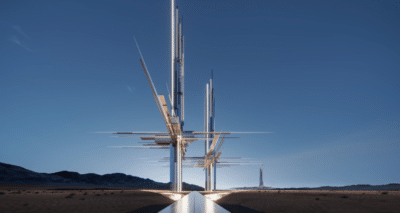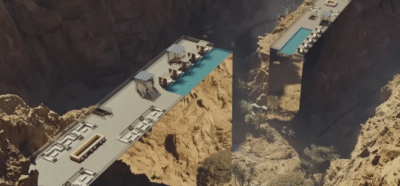In an era where urban development often teeters between innovation and sustainability, a groundbreaking project emerges as a beacon of futuristic living: NEOM’s The Line.
Nestled within the ambitious NEOM megacity project in Saudi Arabia, The Line promises to redefine urban living by blending cutting-edge technology with unprecedented sustainability measures. This article delves into the heart of The Line, exploring how it stands to change living forever and why it’s more than just a city—it’s a glimpse into the future.
IMAGE: NEOM
Understanding NEOM’s The Line
Understanding NEOM’s The Line goes beyond grasping its physical layout or ambitious scale. This visionary project represents a radical departure from traditional urban design, aiming to redefine the essence of city living. At its heart, The Line is a testament to the possibility of harmonizing advanced technology with environmental stewardship.
By eliminating cars and streets, it proposes a lifestyle that prioritizes human health, community, and connectivity over vehicular convenience. This linear city stretches across the desert, envisaging a future where technology and nature coexist seamlessly. It’s not just about creating a new city but about pioneering a new way of life that could set a global benchmark for sustainable urban development.
NEOM – The Line is a direct response to some of the most pressing challenges of our time, including urban sprawl, pollution, and the over-reliance on fossil fuels. By daring to reimagine the urban experience, The Line embodies Saudi Arabia’s commitment to spearheading innovations that could lead not only to a more diversified economy but also to a more sustainable and interconnected world.
A City Built Around Nature, Not Over It
The philosophy underpinning The Line is a profound respect for the environment, positioning it as a city that complements rather than competes with nature. This commitment is evident in every aspect of its design and planning, making it a pioneering example of sustainable urban development.
By choosing to grow vertically rather than horizontally, The Line minimizes its footprint on the earth, preserving vast expanses of the natural landscape for conservation and recreation. This approach not only safeguards biodiversity but also provides residents with an unparalleled quality of life, where the tranquility of nature is just a step away from the conveniences of modern urban living.
The Line’s dedication to environmental stewardship extends to its infrastructure. The city is planned to be powered entirely by renewable energy sources, significantly reducing its carbon emissions and contributing to global efforts against climate change. Water conservation and recycling are also central to its sustainability strategy, ensuring that this precious resource is managed wisely in one of the world’s most arid regions.
NEOM – The Line is not just building a city; it’s crafting an ecosystem. It envisions a world where human habitats enhance the natural environment, creating spaces where wildlife can thrive alongside human communities.
This integration of urban and natural realms promises to offer its inhabitants a unique experience of living in a city that breathes with the land, offering moments of serenity and connection to nature amidst the bustle of city life. Through this innovative approach, The Line stands as a beacon for future cities, showcasing how urban development can be achieved in harmony with the planet.
Innovative Infrastructure for Seamless Living
The innovative infrastructure of The Line is poised to redefine the urban landscape by providing an unparalleled level of connectivity and accessibility. At the core of this transformation is an ultra-modern, high-speed transportation network designed to cover the entire length of the city.
This network is not only a testament to engineering prowess but also to a commitment to sustainability, as it aims to eliminate the reliance on fossil-fuel-powered vehicles, thereby drastically reducing the urban carbon footprint.
Beyond transportation, The Line’s infrastructure is being built with the future in mind, integrating advanced digital technologies that facilitate a seamless and efficient urban experience.
From smart energy management systems that optimize power use to sophisticated waste recycling mechanisms, every element is designed to support a sustainable lifestyle. Additionally, digital services will be embedded into the fabric of The Line, enabling residents to access healthcare, education, and retail services with unprecedented ease and convenience.
This holistic approach extends to the social fabric of NEOM – The Line as well. Public spaces are being designed to foster community interactions and well-being, with green spaces, recreational areas, and cultural venues all interconnected by the city’s transportation and digital networks.
The goal is to create an environment where technology enhances human interactions rather than replacing them, promoting a sense of community and belonging among residents.
By marrying cutting-edge technology with a human-centric design philosophy, The Line’s infrastructure is set to offer a blueprint for future cities. It promises a lifestyle where convenience, sustainability, and well-being are not just ideals but everyday realities, making it a model for seamless living in harmony with technology and nature.
Sustainability at Its Core
Sustainability is not just a buzzword for The Line; it’s the foundation of its existence. The city aims to operate on 100% renewable energy, leveraging the abundant solar and wind resources in the region.
The Line is designed to minimize energy consumption and waste production, incorporating advanced recycling systems and smart urban planning to reduce its environmental footprint significantly.
A Blueprint for Future Cities
Neom – The Line’s groundbreaking approach to urban development extends far beyond its immediate geographical and cultural context, offering a visionary template for global urban planning. This project illuminates a path forward for cities worldwide, demonstrating that it is possible to accommodate growing urban populations without sacrificing environmental integrity or quality of life.
By integrating advanced technologies with a profound commitment to sustainability, The Line challenges outdated models of city living that are reliant on extensive carbon footprints, inefficient transportation systems, and a disconnection from the natural world.
This blueprint for future cities is not just about technological innovation; it’s also about reimagining the social dynamics of urban spaces. The Line proposes a community-centric model, where accessibility to services, green spaces, and public areas fosters a stronger sense of community and well-being. It highlights the importance of designing cities that are not only livable but also conducive to human happiness and health.
Moreover, The Line’s model promotes economic diversification and resilience. By leveraging renewable energy, sustainable technologies, and digital innovation, it points toward a future where cities can be engines of sustainable growth. This approach not only reduces the ecological footprint of urban centers but also offers a roadmap for economic stability in an increasingly unpredictable global landscape.
In essence, The Line embodies a holistic vision for the future of urban living. It illustrates how cities can be designed to be both technologically advanced and deeply connected to the natural environment, providing a sustainable, prosperous, and healthful way of life.
As the world grapples with the challenges of climate change, urbanization, and social inequality, The Line stands as a beacon of hope, showing that another way is not only possible but imperative for the future of our planet and its inhabitants.
The Impact on Global Urban Development
NEOM – The Line represents a paradigm shift in global urban development, offering a compelling vision of how cities can evolve to meet the demands of the 21st century. Its emphasis on sustainability, technology, and human-centric design has set a new benchmark, challenging cities around the world to rethink their approach to urban planning.
The project’s success could catalyze a global movement towards more sustainable, efficient, and livable urban environments, demonstrating that it is possible to harmonize economic development with environmental stewardship.
This impact extends beyond the environmental benefits. By showcasing a model where technology enhances rather than detracts from the quality of life, The Line could inspire urban centers to adopt similar innovations, from smart transportation systems to integrated digital services, improving the efficiency of city services and the well-being of residents.
The Line’s approach to urban density and mixed-use development offers lessons on managing urban sprawl, potentially influencing policies on land use and housing in crowded metropolitan areas.
The Line’s global impact is also seen in its potential to drive economic innovation. By creating a hub for technological advancement and sustainable industries, it positions itself as a catalyst for new economic opportunities, attracting investment, and fostering job creation in green technologies and digital services. This economic model could inspire cities worldwide to invest in similar sectors, promoting economic diversification and resilience.
In essence, Neom – The Line could be a harbinger of a global urban transformation, where cities are not just places to live but ecosystems that support sustainable growth, innovation, and a high quality of life.
Its principles of integrating nature with urban living, prioritizing renewable energy, and leveraging technology for societal benefit could become guiding tenets for the next generation of urban development. As such, The Line has the potential to influence not only the physical landscape of cities but also the economic, social, and environmental paradigms that define them.
Conclusion
NEOM’s The Line stands at the frontier of urban innovation, embodying a vision of the future where cities foster community, sustainability, and connectivity. As we move forward, the principles that guide The Line’s development could inform not just the growth of new cities but the revitalization of existing ones, offering a roadmap to a future where urban living is in harmony with the world around us.
IMAGE: NEOM
If you are interested in even more lifestyle-related articles and information from us here at Notilizer, then we have a lot to choose from.


COMMENTS